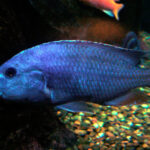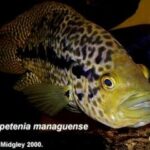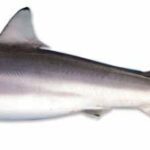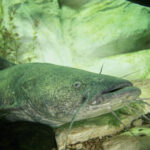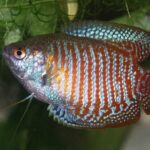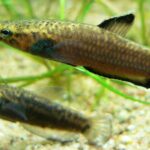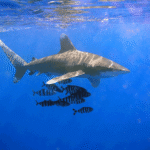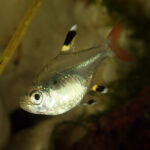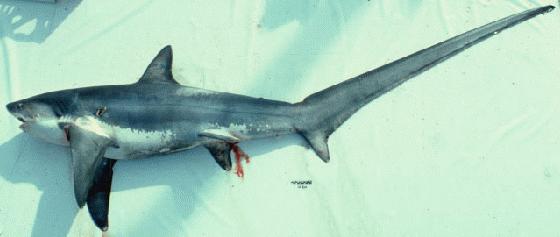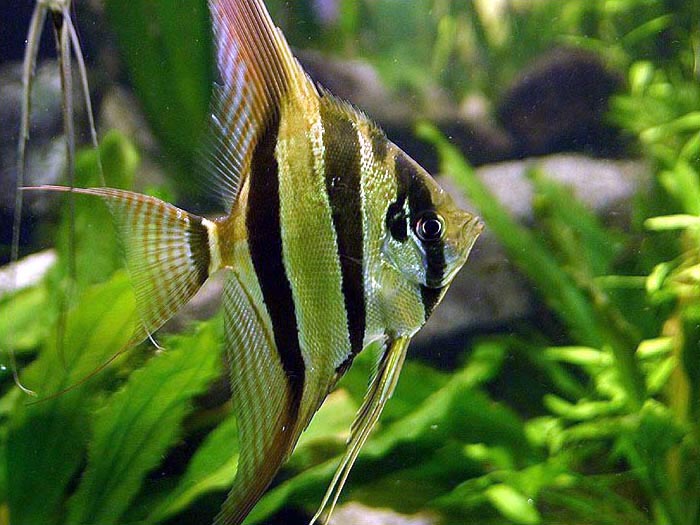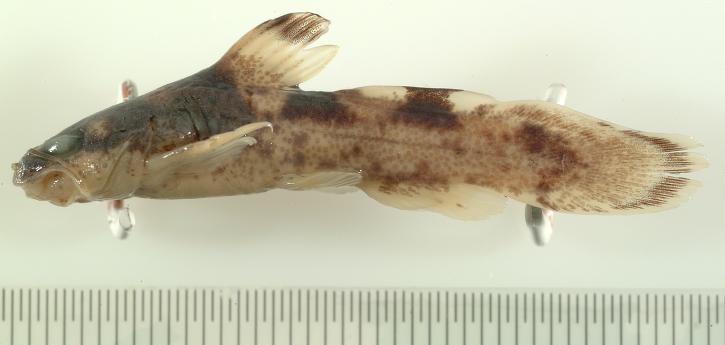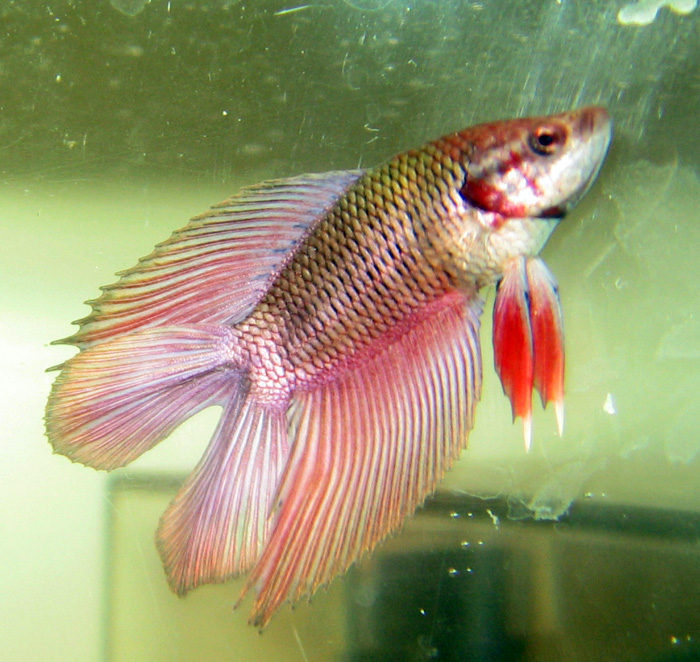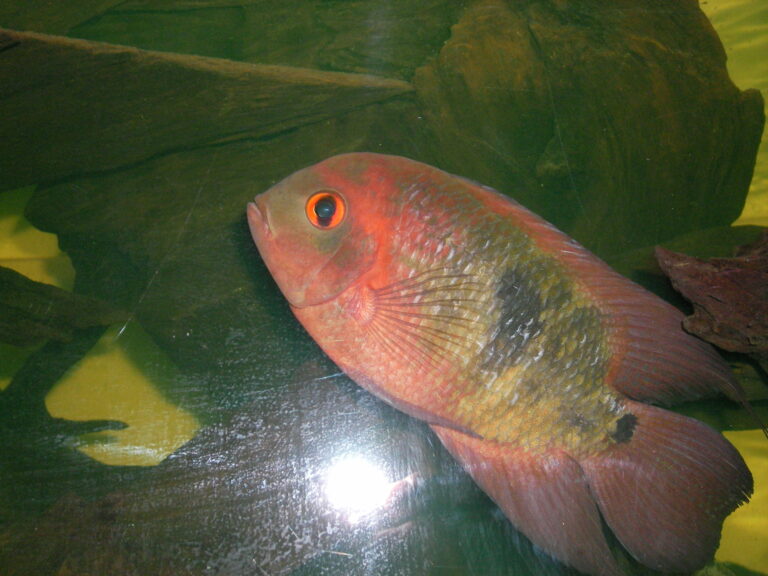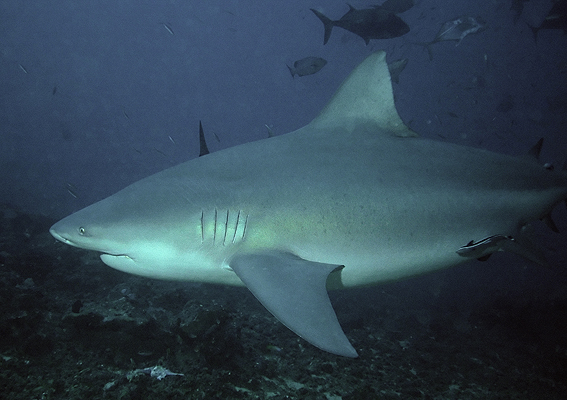Green Terror Cichlid
By Ryan Maron | Last Modified: June 9, 2025

The Green Terror Cichlid stands as one of South America’s most formidable and visually striking freshwater fish species, commanding respect from aquarists and marine biologists alike. Known scientifically as Andinoacara rivulatus, this robust cichlid species has earned its common name through its intense territorial behavior and distinctive metallic coloration that can shift dramatically based on mood and environmental conditions. Native to the Pacific coastal river systems of Ecuador and Peru, the Green Terror Cichlid plays a crucial role as a mid-level predator in its natural ecosystem, helping to regulate populations of smaller fish species while serving as prey for larger predatory species.
This species represents an important component of Neotropical freshwater biodiversity and has become increasingly significant in the global aquarium trade, where its hardy nature and striking appearance have made it a popular choice among experienced cichlid enthusiasts. The Green Terror Cichlid’s ecological role extends beyond simple predation, as these fish contribute to nutrient cycling through their feeding habits and territorial behaviors that influence the distribution of other species within their habitat range.
| Feature | Details |
|---|---|
| Common Name | Green Terror Cichlid |
| Scientific Name | Andinoacara rivulatus |
| Family | Cichlidae |
| Typical Size | 20-25 cm (8-10 inches), 200-400 grams |
| Habitat | Tropical freshwater rivers and tributaries |
| Diet | Omnivorous – small fish, invertebrates, plant matter |
| Distribution | Pacific coastal regions of Ecuador and Peru |
| Conservation Status | Least Concern |
Taxonomy & Classification
The Green Terror Cichlid belongs to the family Cichlidae, one of the most diverse fish families in the world with over 1,700 described species. Originally classified under the genus Aequidens, this species underwent taxonomic revision in the early 2000s when researchers recognized significant morphological and genetic differences that warranted placement in the distinct genus Andinoacara. The genus name Andinoacara reflects the species’ geographic distribution along the Andean coastal regions of South America.
Within the broader classification system, Andinoacara rivulatus sits within the subfamily Cichlasomatinae, which encompasses the majority of Central and South American cichlid species. The species name “rivulatus” derives from Latin, meaning “marked with irregular streaks or channels,” referencing the distinctive patterning visible on the fish’s body and fins. This taxonomic placement distinguishes the Green Terror Cichlid from closely related species such as Andinoacara pulcher and Andinoacara sapayensis, which share similar habitats but exhibit different morphological characteristics.
Recent molecular studies have confirmed the validity of the Andinoacara genus and have helped clarify relationships between various South American cichlid species. These genetic analyses have revealed that the Green Terror Cichlid diverged from its closest relatives approximately 2-3 million years ago, coinciding with major geological changes in the Andean region that created new river systems and isolated populations.
Physical Description
The Green Terror Cichlid exhibits remarkable sexual dimorphism and color variation that makes it one of the most visually distinctive cichlid species. Adult males typically reach lengths of 20-25 centimeters, while females remain slightly smaller at 15-20 centimeters. The body shape is laterally compressed and deep, characteristic of many cichlid species, with a pronounced forehead that becomes more prominent in mature males.
The species’ most striking feature is its iridescent coloration, which can shift from deep emerald green to brilliant blue-green depending on lighting conditions, mood, and breeding status. The base body color ranges from olive-green to metallic blue, overlaid with irregular dark vertical bars that can appear or fade based on the fish’s emotional state. The scales possess a reflective quality that creates an almost jewel-like appearance under proper lighting conditions.
Males develop distinctive features including elongated dorsal and anal fins with flowing extensions, while their foreheads become more pronounced with age, creating the characteristic nuchal hump common to many large cichlid species. Females retain more subdued coloration and lack the extended finnage of males, though they still display the characteristic metallic sheen. Both sexes possess powerful jaws equipped with pharyngeal teeth adapted for processing both plant and animal matter.
The fins of the Green Terror Cichlid deserve particular attention, as they contribute significantly to the species’ appeal. The dorsal fin extends along most of the back, while the anal fin mirrors its shape below. The caudal fin is typically rounded to slightly pointed, and all fins may display intricate patterns of spots, stripes, or iridescent highlights that complement the body coloration.
Habitat & Distribution
The natural range of the Green Terror Cichlid encompasses the Pacific coastal river systems of Ecuador and Peru, specifically the watersheds that drain westward from the Andes Mountains toward the Pacific Ocean. These fish inhabit both primary river channels and smaller tributary streams, typically preferring areas with moderate to slow current flow and abundant structural complexity provided by fallen trees, rock formations, and aquatic vegetation.
Water parameters in their native habitat typically range from slightly acidic to neutral, with pH values between 6.5 and 7.5, and temperatures that remain relatively stable between 22-26 degrees Celsius throughout the year due to the tropical climate. The dissolved oxygen content remains high due to the mountainous terrain and flowing water, while conductivity levels vary seasonally based on rainfall patterns and mineral content from surrounding geology.
The substrate in Green Terror Cichlid habitat consists primarily of sand, gravel, and rocky areas interspersed with patches of finer sediment where organic matter accumulates. This varied bottom composition supports diverse invertebrate communities that form an important part of the species’ diet. The presence of both shallow and deeper areas within their range allows these fish to exploit different ecological niches and adjust their behavior based on seasonal changes in water levels.
Seasonal flooding patterns significantly influence the distribution and behavior of Green Terror Cichlids, as higher water levels during rainy seasons expand available territory and increase food availability. During dry periods, fish may concentrate in deeper pools and main channel areas, leading to increased territorial competition and more pronounced aggressive behaviors that contribute to their common name.
Diet & Feeding Behavior
As omnivorous opportunists, Green Terror Cichlids display remarkable feeding flexibility that has contributed to their success in both natural and captive environments. Their diet consists of a diverse array of food sources including small fish, crustaceans, aquatic insects, worms, and various plant materials. This dietary breadth allows them to adapt to seasonal variations in food availability and exploit different ecological niches within their habitat.
The species employs multiple feeding strategies depending on prey type and availability. When hunting small fish, Green Terror Cichlids utilize ambush tactics, positioning themselves near cover before launching rapid strikes at unsuspecting prey. Their powerful jaws and pharyngeal teeth allow them to process both soft-bodied invertebrates and more challenging prey items such as freshwater crabs and heavily armored insect larvae.
Foraging behavior varies throughout the day, with peak feeding activity typically occurring during dawn and dusk periods when many prey species are most active. These fish demonstrate remarkable problem-solving abilities when searching for food, often moving rocks and debris to uncover hidden invertebrates or excavating shallow depressions in sandy substrates to reach buried organisms.
Plant matter forms a significant component of their diet, particularly during periods when animal protein sources become scarce. Green Terror Cichlids consume various aquatic plants, algae, and fallen terrestrial vegetation, utilizing their specialized pharyngeal teeth to process cellulose-rich materials. This omnivorous feeding strategy helps maintain their energy levels during challenging environmental conditions and contributes to their reputation as hardy, adaptable fish.
Territorial feeding behaviors become particularly pronounced during breeding seasons, when established pairs will aggressively defend feeding territories against conspecifics and other fish species. These territorial displays serve both to secure food resources and to demonstrate fitness to potential mates, linking feeding behavior directly to reproductive success.
Behavior & Adaptations
The Green Terror Cichlid’s behavioral repertoire reflects its evolution as a successful predator and territorial species in competitive freshwater environments. Their territorial nature becomes most apparent during breeding seasons, when established pairs will defend areas of several square meters against intruders, displaying intense aggressive behaviors that include charging, fin spreading, and physical confrontation when necessary.
Social structure within Green Terror Cichlid populations follows a complex hierarchy based on size, age, and breeding status. Dominant individuals secure the most favorable territories with optimal access to food resources and suitable spawning sites, while subordinate fish are relegated to marginal areas with higher predation risk and limited food availability. This social organization helps reduce direct competition and allows populations to utilize available habitat more efficiently.
Communication among Green Terror Cichlids involves a sophisticated array of visual signals, body postures, and color changes. Aggressive displays feature darkened coloration, expanded fins, and lateral presentations designed to appear as large and threatening as possible. Conversely, submissive behaviors include pale coloration, compressed fins, and rapid swimming movements that signal non-threatening intent to dominant individuals.
The species demonstrates remarkable adaptability to changing environmental conditions, adjusting their behavior based on water temperature, oxygen levels, and seasonal variations in habitat structure. During periods of low water levels, these fish may exhibit increased tolerance for crowding and modified territorial boundaries, while high water periods allow for expanded territory establishment and more dispersed population distribution.
Intelligence and learning capacity in Green Terror Cichlids exceed that of many other freshwater fish species, with documented examples of individual recognition, spatial memory for territory boundaries, and adaptive responses to repeated stimuli. These cognitive abilities contribute to their success as both predators and parents, allowing them to navigate complex social situations and environmental challenges effectively.
Reproduction & Life Cycle
The reproductive cycle of Green Terror Cichlids represents one of the most fascinating aspects of their biology, featuring elaborate courtship behaviors, dedicated parental care, and complex social dynamics that ensure offspring survival in challenging natural environments. Sexual maturity typically occurs at 12-18 months of age, coinciding with the development of secondary sexual characteristics and territorial behaviors.
Courtship rituals begin with males establishing and defending territories that include suitable spawning sites, typically flat rocks, cleaned substrate areas, or other stable surfaces where eggs can be safely deposited. Males display intense coloration and perform elaborate swimming patterns designed to attract females, while simultaneously driving away competing males and potential predators from the spawning territory.
Pair formation involves extended courtship periods during which potential mates assess each other’s fitness through various behavioral displays. Successful pairs engage in synchronized swimming, mutual fin displays, and preparatory spawning behaviors that strengthen the pair bond and ensure reproductive synchronization. The female may deposit 200-800 eggs depending on her size and condition, with larger, more mature females producing greater numbers of offspring.
Both parents participate actively in egg and fry care, with the male typically assuming primary territory defense responsibilities while the female focuses on direct offspring care. Eggs hatch after 3-5 days depending on water temperature, and the resulting larvae remain attached to the spawning substrate for an additional 5-7 days while absorbing their yolk sacs. Free-swimming fry receive intensive parental protection and guidance for 4-6 weeks, during which time the parents lead feeding expeditions and provide protection against predators.
The extended parental care period significantly increases offspring survival rates compared to species with no parental investment. Young Green Terror Cichlids learn essential survival skills including predator recognition, feeding techniques, and territorial behaviors through observation and interaction with their parents, creating a foundation for successful independent life.
Predators & Threats
In their natural habitat, Green Terror Cichlids face predation pressure from a variety of larger fish species, aquatic reptiles, and bird species that have shaped their evolution and behavior patterns. Juvenile Green Terror Cichlids are particularly vulnerable to predation from larger cichlid species, catfish, and piscivorous birds such as herons and kingfishers that frequent their riverine habitats.
Adult Green Terror Cichlids possess few natural predators due to their size, aggressive nature, and defensive capabilities, though large catfish species, caimans, and occasionally river dolphins may prey upon them in certain circumstances. The species’ territorial behavior and group defense strategies during breeding seasons provide additional protection against potential predators, as multiple individuals may cooperate to drive away threats.
Human activities represent the most significant contemporary threats to Green Terror Cichlid populations, including habitat modification through dam construction, agricultural runoff, and urban development that alters water chemistry and flow patterns. Mining activities in the Andean headwaters of their range introduce heavy metals and sediments that can affect water quality and food web structure.
Climate change poses emerging challenges through altered precipitation patterns that affect seasonal flooding cycles essential for reproduction and territory establishment. Changes in water temperature and flow regimes may disrupt the delicate balance of their ecosystem and affect food availability throughout their range.
Collection pressure for the international aquarium trade has historically impacted some populations, though successful captive breeding programs have reduced demand for wild-caught specimens. Nonetheless, continued monitoring of wild populations remains important to ensure sustainable exploitation levels and prevent localized population declines.
Invasive species introductions in some parts of their range create additional competitive pressure and may alter ecosystem dynamics in ways that disadvantage native Green Terror Cichlid populations. These complex interactions require ongoing research to understand their full implications for species conservation.
Conservation Status
The International Union for Conservation of Nature currently classifies the Green Terror Cichlid as a species of Least Concern, reflecting its relatively stable population status and broad distribution across suitable habitat within its native range. However, this classification requires regular reassessment as environmental pressures continue to intensify throughout South America’s Pacific coastal watersheds.
Population monitoring efforts conducted by regional fisheries agencies and academic institutions suggest that Green Terror Cichlid numbers remain stable in most areas, though some localized declines have been documented in heavily developed watersheds. The species’ adaptability and reproductive success contribute to its resilience against moderate environmental disturbances, but ongoing habitat degradation remains a concern for long-term population viability.
Conservation efforts focus primarily on watershed protection and restoration, recognizing that healthy river ecosystems benefit not only Green Terror Cichlids but entire communities of native fish species. International cooperation between Ecuador and Peru has led to the establishment of several protected areas that include critical Green Terror Cichlid habitat, though enforcement and management capacity remain limited in some regions.
Research initiatives supported by universities and conservation organizations continue to study Green Terror Cichlid ecology and population dynamics, providing essential data for management decisions and conservation planning. These studies have revealed important information about habitat requirements, reproductive success factors, and responses to environmental stressors that inform protection strategies.
Captive breeding programs in the aquarium trade have successfully reduced pressure on wild populations while maintaining genetic diversity through careful breeding management. These programs serve as valuable backup populations and provide opportunities for research that would be difficult to conduct in natural settings.
Human Interaction
The relationship between humans and Green Terror Cichlids encompasses multiple dimensions including aquarium keeping, scientific research, and local fisheries utilization. In the international aquarium trade, these fish have gained tremendous popularity among cichlid enthusiasts who appreciate their striking appearance, interesting behaviors, and relatively hardy nature compared to more sensitive species.
Successful maintenance of Green Terror Cichlids in captivity requires understanding of their territorial nature and specific water quality requirements. Experienced aquarists typically house these fish in large aquariums with robust filtration systems and carefully selected tankmates that can coexist with their aggressive tendencies. The species has proven adaptable to aquarium conditions when provided with appropriate environmental parameters and nutrition.
Scientific research involving Green Terror Cichlids has contributed valuable insights into cichlid evolution, behavior, and ecology that extend beyond this single species. Studies of their reproductive behavior, territorial dynamics, and adaptive responses have enhanced understanding of fish behavior and evolution more broadly, making them important model organisms for behavioral and evolutionary research.
In their native range, Green Terror Cichlids support small-scale subsistence and commercial fisheries, though they typically represent a minor component of total catch compared to larger commercial species. Local fishing communities have developed traditional knowledge about the species’ behavior and habitat preferences that proves valuable for both fisheries management and scientific research.
Educational and conservation programs increasingly feature Green Terror Cichlids as flagship species for freshwater ecosystem conservation, using their charismatic appearance and interesting behaviors to engage public interest in South American aquatic biodiversity. These programs help build support for habitat protection and sustainable resource management throughout their range.
The species’ popularity in aquarium keeping has also created economic opportunities for local communities through sustainable collection and breeding operations, provided these activities are properly managed to prevent overexploitation of wild populations.
Interesting Facts
The Green Terror Cichlid possesses several remarkable characteristics that distinguish it from other cichlid species and contribute to its fascination among fish enthusiasts and researchers. Their ability to change coloration rapidly in response to environmental conditions or emotional states rivals that of marine fish species, with color shifts occurring within seconds when faced with threats or during courtship displays.
Individual Green Terror Cichlids demonstrate remarkable longevity compared to many freshwater fish species, with documented lifespans exceeding 15 years in optimal conditions. This extended lifespan allows for the development of complex learned behaviors and social relationships that continue to surprise researchers studying their cognitive abilities.
The species exhibits unusual problem-solving capabilities, including the ability to recognize individual humans who regularly interact with them and adapt their behavior accordingly. Aquarium-kept specimens often learn to associate specific visual cues with feeding times and may even respond differently to different family members based on their past interactions.
Green Terror Cichlids possess a sophisticated lateral line system that allows them to detect minute water movements and pressure changes, enabling them to locate hidden prey and detect approaching predators with remarkable precision. This sensory adaptation proves particularly valuable in their natural habitat where visibility may be limited by turbid water conditions.
The species demonstrates remarkable site fidelity, with individual fish often returning to the same territories year after year and showing detailed spatial memory for their home ranges. This behavior indicates complex cognitive mapping abilities that exceed those documented in many other fish species, suggesting advanced neurological development related to their territorial lifestyle.
Their breeding behavior includes unique parental communication methods, with adults producing specific low-frequency sounds and vibrations to communicate with their offspring and coordinate family group movements. These acoustic signals represent an understudied aspect of cichlid communication that may prove important for understanding their social complexity.
Frequently Asked Questions
What tank size is required for keeping Green Terror Cichlids?
A minimum tank size of 300 liters (75 gallons) is recommended for a pair of adult Green Terror Cichlids, with larger tanks preferred to accommodate their territorial nature and provide adequate swimming space. The aquarium should include robust filtration, stable water parameters, and plenty of hiding places to reduce stress and aggressive interactions.
Can Green Terror Cichlids be kept with other fish species?
Green Terror Cichlids can coexist with carefully selected tankmates, but their aggressive and territorial nature limits compatible species options. Suitable companions include other large, robust cichlid species, large catfish, and similarly sized fish that can defend themselves. Small or peaceful species should be avoided as they may become targets of aggression.
How can you distinguish between male and female Green Terror Cichlids?
Males typically grow larger than females, develop more pronounced foreheads with age, and possess longer, more pointed dorsal and anal fins. Males also display more intense coloration and territorial behaviors, while females remain smaller with more subdued colors and rounded fins. These differences become more apparent as the fish reach sexual maturity.
What water parameters do Green Terror Cichlids require?
Green Terror Cichlids thrive in water temperatures between 22-26°C (72-79°F), with pH levels ranging from 6.5 to 7.5, and moderate hardness levels. Regular water changes and efficient filtration are essential to maintain water quality, as these fish produce significant biological waste and are sensitive to poor water conditions.
Conclusion
The Green Terror Cichlid represents a remarkable example of Neotropical freshwater fish diversity, combining striking visual appeal with complex behavioral adaptations that have enabled their success in challenging riverine environments. Their role as both predator and prey within South American aquatic ecosystems underscores the interconnected nature of freshwater biodiversity and the importance of protecting intact watershed systems. As continuing research reveals new insights into their behavior, ecology, and conservation needs, the Green Terror Cichlid serves as both a charismatic ambassador for freshwater conservation and a valuable model for understanding cichlid evolution and adaptation in changing environments.
Share The Article:
More Fish Species:
-
Dalmatian Molly
The Dalmatian Molly stands as one of the most recognizable and beloved freshwater aquarium fish, distinguished by its striking…
-
Pearl Gourami
The Pearl Gourami stands as one of the most recognizable and ecologically significant members of the labyrinth fish family,…
-
Thresher Shark
The Thresher Shark represents one of the ocean’s most distinctive and captivating apex predators, renowned for its extraordinarily elongated…
-
Angelfish
Angelfish represent one of the most recognizable and ecologically significant families of marine fish, encompassing over 85 species distributed…
-
Madtom Catfish
The Madtom Catfish represents one of North America’s most fascinating yet underappreciated groups of freshwater fish. These diminutive members…
-
Double Tail Betta
The Double Tail Betta, scientifically known as Betta splendens, represents one of the most distinctive and captivating variants within…
Discover
-
Texas Fishing License Guide: 2025 Costs & Requirements
I still remember the day a Texas game warden approached me on Lake Texoma while I was reeling in…
-
Fishing in Long Beach: Best Guide (Local Secrets Revealed)
There’s something magical about casting a line along the Southern California coast, especially when fishing in Long Beach. I’ve…
-
European Pike Fishing: Top Techniques for Northern Pike
I still remember my first encounter with European pike fishing methods. It was during a trip to Sweden about…
-
Croaker Fishing Secrets: Why Most Anglers Miss the Big Ones
Croaker fishing might seem straightforward, but there’s more to catching these tasty fighters than most weekend anglers realize. I’ve…
-
5 Deadly Trolling Tactics Big Fish Can’t Resist
The first time I watched a 40-pound king salmon completely ignore my perfect trolling setup, I wanted to throw…
-
Louisiana Redfish Fishing: Best Spots & Tactics for Beginners
Finding that first bull red is a moment you never forget. The pull, the power – it’s something special….
Discover
-
Chocolate Cichlid
The Chocolate Cichlid stands as one of South America’s most distinctive freshwater species, captivating aquarists and researchers alike with…
-
Best Fishing Lures for Walleye: Pro Secrets You Won’t Believe
Let me tell you something about walleye fishing that most anglers get completely wrong. After 30+ years of chasing…
-
Bull Shark
The Bull Shark represents one of the most formidable apex predators in marine ecosystems worldwide. Known scientifically as Carcharhinus…
-
Stonecat
The Stonecat (Noturus flavus) represents one of North America’s most distinctive freshwater catfish species, serving as a crucial indicator…
-
King Mackerel Fishing: Top Strategies for Landing Smokers
Some days on the water just stick with you. Few things compare to that first time a king mackerel…
-
15 Panfish Fishing Secrets: Easy Catches for Beginners & Pros
You know what’s funny about panfish? These little fighters have probably hooked more new anglers than any other species,…

